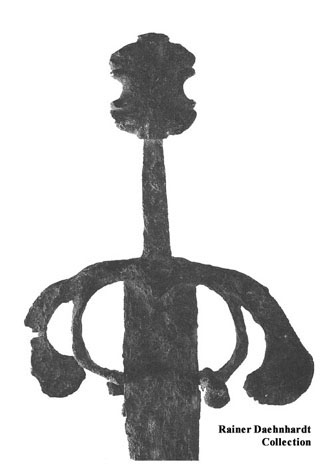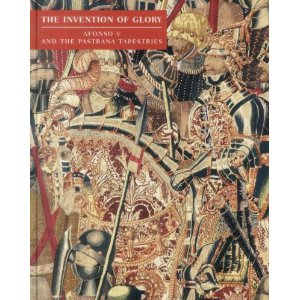Hello there!
I'm Carlos Carvão, from Portugal (more specifically, Lisbon). I work at a museum in Cascais, Condes de Castro Guimarães Museum http://www.cm-cascais.pt/equipamento/museu-bi...-guimaraes (sorry, it's in portuguese!), which is going to be the future home for a late 15th - early 16th century sword that was found nearby, in 1975.
So, I'm here searching for any information you can give, regarding similar swords you've seen, being actual swords or even representations of similar swords (painting, sculpture...), makers, possible design origins or influences (for example, Spain)... anything, really.
This is all for an official investigation I'm doing, so that the information I find can be included alongside with the sword, when permanently displayed at the museum.
I'm going to give you the information I've got thus far.
It was found in a chapel called Ermida de Nossa Senhora da Conceição da Abóboda, in São Domingos de Rana, Carcavelos (near cascais), in a tomb of a knight known as D. Diogo de Azevedo. This is where it starts to become tricky. We still don't know much about him, since in the tomb there was at least two more bodies. Also, there is other knight with the same name. So, this part of the investigation (fairly important) is still to be done.
Here it is:
http://s3.amazonaws.com/data.tumblr.com/tumbl...o1_500.jpg
About the blade, the archaeological data they gave me only says that it is made of iron. The length of the latter is (in centimeters) 86,5cm. It's width/diameter is 3 to 4cm and thickness is 0,2 to 0,6cm.
The guard and pommel are made of a non ferrous metal (possibly lead) and show remains of gold. The guard has only one side, so they don't give the length. Its width/diameter is of 11,5cm and thickness of 04 to 2,4cm.
The pommel's length is 5,5cm, with a width/diameter of 4cm and thickness of 2cm.
The tang's lenght of 7,5cm and thickness 1,4 to 2,4cm.
http://s3.amazonaws.com/data.tumblr.com/tumbl...o1_500.jpg
http://s3.amazonaws.com/data.tumblr.com/tumbl...o1_500.jpg
In the blade there are three markings, probably of the maker:
1) (I'll call this the bottom side. It has only one marking, is which there are two incisions).
http://s3.amazonaws.com/data.tumblr.com/tumbl...o1_500.jpg
2) (The upper side, in which there are two markings. The first is similar to the one seen in the bottom side, and it is located at about the same place in the blade. The second is a more complex marking, also incised).
http://s3.amazonaws.com/data.tumblr.com/tumbl...o1_500.jpg
Here you can see a more detailed drawing of that marking, as well as the profile of the blade:
http://s3.amazonaws.com/data.tumblr.com/tumbl...o1_500.jpg
We found a representation of a similar sword in a very famous portuguese painting of this era, the "Painéis de São Vicente de Fora" by Nuno Gonçalves. http://pt.wikipedia.org/wiki/Pain%C3%A9is_de_...te_de_Fora
More specifically: http://pt.wikipedia.org/wiki/Ficheiro:Nu%C3%B...es_001.jpg
There is a big difference between the swords in the painting and the subject one. The ones on the painting have some type of teeth under the guard, which the subject one has not. That is what confuses us, because they are quite similar and that could help us a lot. We don't know if it really is a portuguese or a spanish sword, or if it is a portuguese sword with spanish influences, we aren't sure about the date (when I have more info about the knight, this one should be easy to solve)... we only suspect it was a parade sword (I'm lacking the word here). We think it wasnt a sword for battle but more a sword to walk around with.
Some more photos, that might be helpful:
http://s3.amazonaws.com/data.tumblr.com/tumbl...4_1280.jpg
http://s3.amazonaws.com/data.tumblr.com/tumbl...1_1280.jpg
http://s3.amazonaws.com/data.tumblr.com/tumbl...2_1280.jpg
http://s3.amazonaws.com/data.tumblr.com/tumbl...3_1280.jpg
http://s3.amazonaws.com/data.tumblr.com/tumbl...5_1280.jpg
http://s3.amazonaws.com/data.tumblr.com/tumbl...6_1280.jpg
Thank you very much for the time you decide to give to my shout for help. If you need any more information, just ask and I'll try to find it! When I find more info, I'll share it with you, if you are interested.
I'm sorry for all the links, but that way you get to see the photos in their best quality.
If you need to contact me, here's my e-mail: carvonman@gmail.com
Hello Carlos,
Have you seen this sword, also in Lisbon?
http://www.forensicfashion.com/1471AvisKnightSword.html
La Rocca (2011) discusses these swords briefly as they appear in the Pastrana Tapestries:
http://www.forensicfashion.com/1471AvisKnight.html
Have you seen this sword, also in Lisbon?
http://www.forensicfashion.com/1471AvisKnightSword.html
La Rocca (2011) discusses these swords briefly as they appear in the Pastrana Tapestries:
http://www.forensicfashion.com/1471AvisKnight.html
It reminds me of this one, originally captioned:
 Attachment: 21.58 KB
Attachment: 21.58 KB

| Quote: |
| Sword attributed to Pedro Álvares Cabral, discovered Brasil, 1500.
Unearthed from his Tomb. |

Ruel A. Macaraeg, I have heard about that one, so I have a visit to the Military Museum scheduled to see it. :) And the references and bibliography will be very helpful! I've heard about the tapestries, but not regarding this type of swords! Thank you very much!
Michael Harley, I didn't know about Pedro Álvares Cabral's sword! I'm going to pay some more attention to it now. Thank you!
Do you know any free sites where I can search a database of swords and maker's marks?
Thank you once again for your help!
Michael Harley, I didn't know about Pedro Álvares Cabral's sword! I'm going to pay some more attention to it now. Thank you!
Do you know any free sites where I can search a database of swords and maker's marks?
Thank you once again for your help!
"The Invention of Glory: Afonso V and the Pastrana Tapestries" is a fantastic visual reference for Portuguese arms and armour of this period.
http://www.amazon.de/The-Invention-Glory-Past...amp;sr=8-1
Afonso is shown on the cover with a sword of this type.
If I remember correctly, Oakeshott discusses the type in his "European Weapons and Armour: From the Renaissance to the Industrial Revolution Boydell Press, 2000. ISBN 0-85115-789-0"
 Attachment: 33.04 KB
Attachment: 33.04 KB

http://www.amazon.de/The-Invention-Glory-Past...amp;sr=8-1
Afonso is shown on the cover with a sword of this type.
If I remember correctly, Oakeshott discusses the type in his "European Weapons and Armour: From the Renaissance to the Industrial Revolution Boydell Press, 2000. ISBN 0-85115-789-0"

Interesting sword!
This hilt type is listed by AVB Norman in "The Rapier and Small-Sword 1460-1820" (ISBN 0-405-13089-9 and 978-0-405-13089-2) as "Hilt 16". Although this sword is perhaps not a "true" rapier it is generally considered a predecessor, a type of sword known as a "side-sword". Norman's type has the "pas d'ane" (the small semicircular parts of the guard present in the sword of Pedro Álvares Cabral, where your sword does not have them. Other examples of the type as per Norman:
- Instituto de Valencia de Don Juan, Cat. No. 59
- Real Armeria Madrid, Cat. No. G.31 (said to be of Ferdinand V of Castile and Leon II of Aragon)
- A number of paintings (Prado 2902, National Gallery 895, Pitti Palace Florence 311)
- A sword from the collection of Sir James Mann with a blade signed ME FECIT / BISCOTTO (made in Villa Basilica, close to Lucca)
- Musee de l'Armee Inv.No. P.O.2766
Norman dates the type from the last quarter of the 15th C. to about 1550). He has more interesting details, but I don't feel like typing all of it. :) If you can't find the book, let me know and I can scan the pages for you.
The blade is Oakeshott Type XIX.
These incisions seem to me the transition between the ricasso (unsharpened part of the blade, near the guard) and the actual edge. Although in your sword, this transition seems to be unusually far from the guard.
Here are some pictures of how it looks on a high quality reproduction:
http://www.albion-swords.com/swords/albion/ne...photos.htm
The other markings are not necessarily maker's marks. They may also have a decorative and/or religious function.
This hilt type is listed by AVB Norman in "The Rapier and Small-Sword 1460-1820" (ISBN 0-405-13089-9 and 978-0-405-13089-2) as "Hilt 16". Although this sword is perhaps not a "true" rapier it is generally considered a predecessor, a type of sword known as a "side-sword". Norman's type has the "pas d'ane" (the small semicircular parts of the guard present in the sword of Pedro Álvares Cabral, where your sword does not have them. Other examples of the type as per Norman:
- Instituto de Valencia de Don Juan, Cat. No. 59
- Real Armeria Madrid, Cat. No. G.31 (said to be of Ferdinand V of Castile and Leon II of Aragon)
- A number of paintings (Prado 2902, National Gallery 895, Pitti Palace Florence 311)
- A sword from the collection of Sir James Mann with a blade signed ME FECIT / BISCOTTO (made in Villa Basilica, close to Lucca)
- Musee de l'Armee Inv.No. P.O.2766
Norman dates the type from the last quarter of the 15th C. to about 1550). He has more interesting details, but I don't feel like typing all of it. :) If you can't find the book, let me know and I can scan the pages for you.
The blade is Oakeshott Type XIX.
| Carlos Carvão wrote: |
|
In the blade there are three markings, probably of the maker: 1) (I'll call this the bottom side. It has only one marking, is which there are two incisions). http://s3.amazonaws.com/data.tumblr.com/tumbl...o1_500.jpg |
These incisions seem to me the transition between the ricasso (unsharpened part of the blade, near the guard) and the actual edge. Although in your sword, this transition seems to be unusually far from the guard.
Here are some pictures of how it looks on a high quality reproduction:
http://www.albion-swords.com/swords/albion/ne...photos.htm
The other markings are not necessarily maker's marks. They may also have a decorative and/or religious function.
Hello there!
Sean Flynt, yes, those are now mandatory reads! Thank you for your help!
Paul Hansen, that is wonderful info! Some things I actualy haven't though about yet.
Your list gave me a lot to work with, so now I should be able to find some good information about the sword. I'm going to start ordering some books and to pay attention to the references you gave me. It has been a great help! Thanks a lot for that.
Let's hope I find the book, so you won't have to do that! ;)
Once again, thanks a lot for all your help! :)
As I said, when I reach some conclusions, I'll share them with you. [/quote]
Sean Flynt, yes, those are now mandatory reads! Thank you for your help!
Paul Hansen, that is wonderful info! Some things I actualy haven't though about yet.
Your list gave me a lot to work with, so now I should be able to find some good information about the sword. I'm going to start ordering some books and to pay attention to the references you gave me. It has been a great help! Thanks a lot for that.
Let's hope I find the book, so you won't have to do that! ;)
Once again, thanks a lot for all your help! :)
As I said, when I reach some conclusions, I'll share them with you. [/quote]
Page 1 of 1
You cannot post new topics in this forumYou cannot reply to topics in this forum
You cannot edit your posts in this forum
You cannot delete your posts in this forum
You cannot vote in polls in this forum
You cannot attach files in this forum
You can download files in this forum
All contents © Copyright 2003-2006 myArmoury.com — All rights reserved
Discussion forums powered by phpBB © The phpBB Group
Switch to the Full-featured Version of the forum
Discussion forums powered by phpBB © The phpBB Group
Switch to the Full-featured Version of the forum